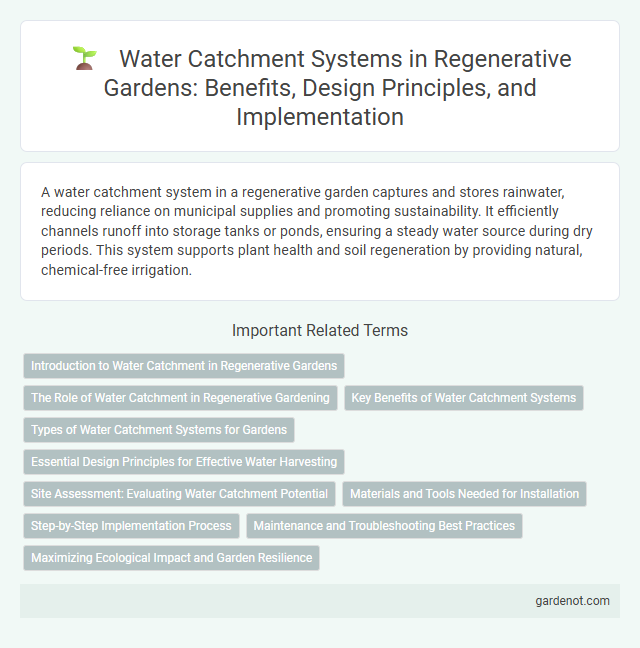A water catchment system in a regenerative garden captures and stores rainwater, reducing reliance on municipal supplies and promoting sustainability. It efficiently channels runoff into storage tanks or ponds, ensuring a steady water source during dry periods. This system supports plant health and soil regeneration by providing natural, chemical-free irrigation.
Introduction to Water Catchment in Regenerative Gardens
Water catchment systems in regenerative gardens harness rainfall to reduce dependence on external water sources and promote sustainability. These systems include rainwater harvesting techniques such as gutters, storage tanks, and swales that direct and store water for irrigation and groundwater recharge. By optimizing water retention and minimizing runoff, water catchment enhances soil health and supports thriving plant ecosystems.
The Role of Water Catchment in Regenerative Gardening
Water catchment systems play a crucial role in regenerative gardening by efficiently harvesting and storing rainwater to reduce dependence on municipal water supplies. These systems promote soil health and plant growth by providing a consistent water source that supports natural soil moisture levels and minimizes erosion. Implementing rainwater harvesting methods like rain barrels and swales enhances water conservation and resilience in sustainable gardening practices.
Key Benefits of Water Catchment Systems
Water catchment systems conserve rainwater, reducing dependence on municipal supplies and lowering water bills. They enhance groundwater recharge and improve soil moisture, boosting plant health and resilience during droughts. By minimizing runoff, these systems prevent erosion and decrease pollutant flow into local waterways, supporting ecosystem sustainability.
Types of Water Catchment Systems for Gardens
Rainwater harvesting, including rooftop catchment systems, efficiently collects water by channeling precipitation from roof surfaces into storage tanks for garden irrigation. Surface catchment systems, such as ponds or swales, capture runoff directly from landscaped areas, promoting groundwater recharge and reducing soil erosion. Subsurface catchment involves underground infiltration methods like trenches or soak pits, enhancing water retention and minimizing evaporation in regenerative garden designs.
Essential Design Principles for Effective Water Harvesting
A water catchment system in regenerative gardens must prioritize contouring the landscape to maximize runoff capture and minimize erosion while directing water flow toward storage areas like swales or ponds. Designing permeable surfaces and integrating mulches enhance infiltration and reduce evaporation, supporting sustainable moisture retention. Incorporating native, drought-resistant plants further optimizes water use efficiency and resilience during dry periods.
Site Assessment: Evaluating Water Catchment Potential
Evaluating water catchment potential begins with analyzing site topography, soil permeability, and rainfall patterns to determine optimal water collection points. Accurate assessment includes measuring catchment surface area and runoff coefficients to estimate water yield effectively. Integrating this data supports sustainable design of rainwater harvesting systems that maximize water retention and minimize erosion in regenerative gardens.
Materials and Tools Needed for Installation
Installation of a water catchment system in a regenerative garden requires durable materials like food-grade PVC pipes, storage tanks with UV protection, gutters, and downspouts for efficient water collection. Essential tools include a power drill, pipe cutter, sealant, mounting brackets, and a water filter to ensure clean storage. Proper selection of corrosion-resistant components and waterproof sealants enhances the longevity and performance of the system.
Step-by-Step Implementation Process
Install gutters and downspouts to channel rainwater from rooftops into storage tanks, ensuring proper filtration to prevent debris contamination. Connect overflow outlets to secondary storage or irrigation systems to maximize water usage during heavy rainfall. Regularly inspect and maintain the system components to ensure optimal water collection efficiency and longevity.
Maintenance and Troubleshooting Best Practices
Regular inspection of gutters, downspouts, and storage tanks is essential for maintaining an efficient water catchment system in a regenerative garden. Removing debris and checking for leaks or blockages prevents water loss and ensures optimal flow. Implementing a routine maintenance schedule helps identify issues early, while troubleshooting common problems involves clearing clogs, sealing leaks, and ensuring proper filtration to sustain a reliable water supply.
Maximizing Ecological Impact and Garden Resilience
A water catchment system in a regenerative garden captures and stores rainwater to maximize ecological benefits by reducing runoff and supporting native plant biodiversity. Integrating swales, rain gardens, and permeable surfaces promotes groundwater recharge and enhances soil moisture retention, improving garden resilience during droughts. This system also filters pollutants, creating a sustainable water source that maintains healthy ecosystems and reduces dependency on external water supplies.
Water catchment system Infographic

 gardenot.com
gardenot.com